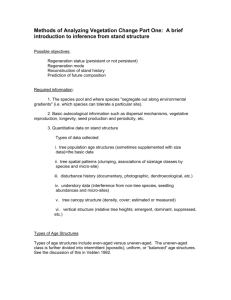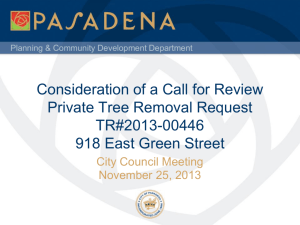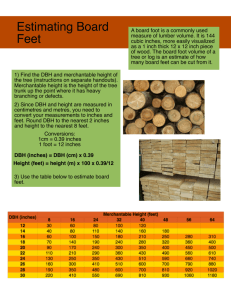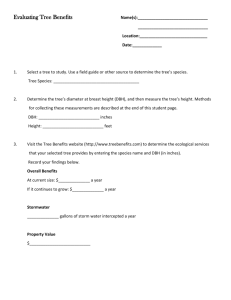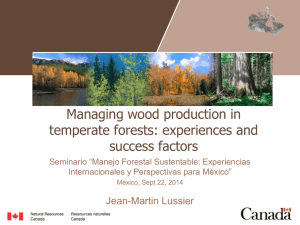• ► 010-47
advertisement
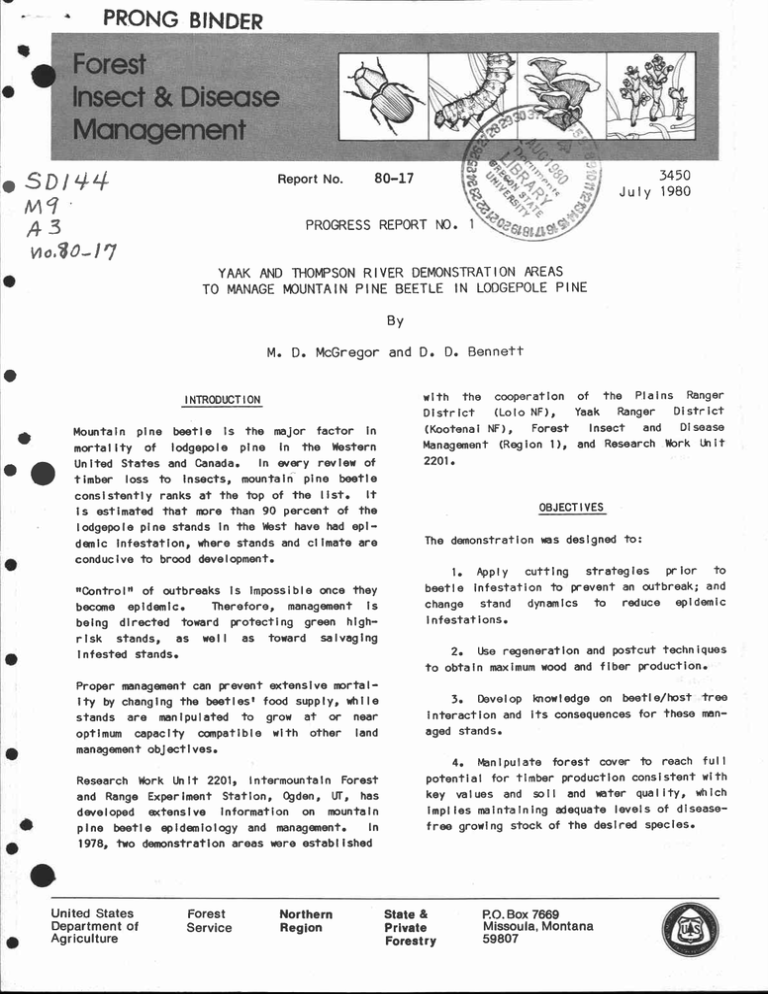
"W. PRONG BINDER - • • • Fl; insect & Disease Management n • SD/44 Report No. 80-17 645, S) 0 4)-4 cf;) 1% 4'4:11;<? 4 121' PROGRESS REPORT NO. 1 43 "cte, ► 010-47 • 47 3450 July 1980 0.181/11: YAAK AND THOMPSON RIVER DEMONSTRATION AREAS TO MANAGE MOUNTAIN PINE BEETLE IN LODGEPOLE PINE By M. D. McGregor and D. D. Bennett • INTRODUCTION Mountain pine beetle Is the major factor in • • • mortality of lodgepole pine in the Western United States and Canada. In every review of timber loss to insects, mountain pine beetle with the cooperation of the Plains Ranger Yaak Ranger District (Lolo NF), District (Kootenai NF), Forest Insect and Disease Management (Region 1), and Research Work Unit 2201. consistently ranks at the top of the list. It is estimated that more than 90 percent of the lodgepole pine stands In the West have had epidemic infestation, where stands and climate are • OBJECTIVES The demonstration was designed to: conducive to brood development. "Control" of outbreaks is Impossible once they become epidemic. Therefore, management is being directed toward protecting green high- Apply cutting strategies prior to 1. beetle infestation to prevent an outbreak; and change stand dynamics to reduce epidemic Infestations. risk stands, as well as toward salvaging • • Infested stands. Use regeneration and postcut techniques 2. to obtain maximum wood and fiber production. Proper management can prevent extensive mortality by changing the beetles' food supply, while stands are manipulated to grow at or near Develop knowledge on beetle/host tree 3. interaction and its consequences for these man- optimum capacity compatible with other land aged stands. management objectives. Research Work Unit 2201, Intermountain Forest and Range Experiment Station, Ogden, UT, has developed extensive information on mountain • pine beetle epidemiology and management. In 1978, two demonstration areas were established • Manipulate forest cover to reach full 4. potential for timber production consistent with key values and soil and water quality, which implies maintaining adequate levels of diseasefree growing stock of the desired species. • • United States Department of Agriculture Forest Service Northern Region State & Private Forestry P.O. Box 7669 Missoula, Montana 59807 class per plot. Phloem thickness was measured METHODS to the nearest one-hundredth of an inch with a An area of approximately 2,000 acres was steel ruler. selected on each Forest for the demonstration. Each area was divided into units of approximately 10-30 acres. On the Kootenai, 19 units received a cutting strategy and 3 units were designated as checks (figure 1, table 1). On Additional data were collected for site index; habitat type; age and growth rate; elevation; basal area, stems/acre; aspect; slope; and crown competition factor. the Lolo, 16 units received a cutting strategy, with 3 designated as checks (figure 2, table 2). Areas were resurveyed for new attacks following Prior to cutting, each unit was cruised for infested trees. These estimates were obtained Research Work Unit 2201 collected data for 2 cutting in 1979. by establishing 1/4-acre plots at 5-chain intervals throughout each unit. A hypsometer years on the Kootenai units and for 1 year on the Lolo units concerning associated insects and emigration/Immigration of mountain pine was used to determine if trees were within plot beetle at different crown levels. boundaries. Trees 5 inches d.b.h. and larger were tallied and classed as follows: RESULTS 0 = Green All units have been established, cruised, and 1 = Current attack, brood present 2 = 1-year-old attack, brood present cut, and the first postcut survey has been made. 3 = 1-year-old or prior attack 4 = Unsuccessful attack or pitchout; green foliage, pitchtubes present, brood and blue Data on infestations and cutting are shown in tables 1 and 2. Each unit will be cruised again following beetle flight in 1980, and stain absent 5 = Strip attack attacks/acre will be compared to the number before cutting. Tables 3 and 4 show habitat type, elevation, aspect, slope, and soils type. Twenty 1/10-acre plots also were established to determine diameter-phloem distribution within A hypsometer was used to tally the stand. trees, which were recorded by d.b.h. Two phloem samples were taken from the opposite sides of each of two trees in each diameter Data are being collected annually through 1982 to show the relationship between attacks/acre and these factors. Stands will be reevaluated in 1987 and 1992. • • 2 • • • Table 1.--Unit Information Yaak Demonstration Areas, Kootenai NF, 1976-79 • Designated cut Unit No. Waper Creek Hensley Creek Logged Attacks/acre Acres 1976 1977 1978 1979 43F 7.6 4.4 6.4 6.4 1.6 3.6 15.6 2.4 5.0 14.7 10.5 4.0 306.0 64.0 58.0 15.3 3 4 Leave 100 BA Leave 80 BA 20 16 14 Check 25 4.6 0.4 7.6 1 Cut >10" dbh 17 7.2 11.2 2.6 2.8 3.8 2.0 1.6 0.6 3.6 4.8 226.0 3.4 0.4 3.2 36.0 17.5 206.0 86.0 1.3 208.0 0.4 0.2 2.0 0.4 0.5 3.1 86.0 323.0 55.1 106.0 1 2 Leave >12" dbh 2 Leave 120 BA 16 3 4 5 6 Leave 80 BA Cut >12" dbh Cut >12" dbh Cut >7" dbh 18 10 14 18 4.8 1.8 7 Cut >12" dbh 21 0.8 3.8 13.2 Cut >7" dbh 16 1.2 0.4 0.2 Benefield Creek 1 Not logged 207.0 until late winter 2 • S 0 62.2 0 0 0 0.2 .8 0.2 4.4 0 0 0 0 2.6 0 Not logged until late winter 68.9 Leave 100 BA Leave 80 BA Cut >10" dbh 19 16 16 0.4 1.6 0.8 0.4 0 1.2 6 Cut >10" dbh 18 7 8 9 Leave 100 BA Leave 120 BA Cut >7" dbh 14 18 0.2 1.4 17 0 8.8 0.6 0.6 1.8 0.8 17.2 1.6 0.2 Check Check 23 2.2 5.2 10.8 25 6.0 7.2 16.4 11 • 28 3 4 5 10 • Leave 120 BA 51.6 117.0 17.1 157.9 87.9 145.9 173.9 177.7 Table 2.--Unit Information, Thompson River Demonstration Areas, Lolo NF, 1976-79 Attacks/acre Designated Unit No. 14A 15 19 4 7 16 2 3 8 1 12 5 9 Acres cut Cut >7" dbh Cut >7" dbh Cut Cut Cut Cut Cut Cut Cut >7" dbh >10" dbh >10" dbh >10" dbh >12" dbh >12" dbh >12" dbh 15 25 31 19 21 1976 7 164 -- 1978 1979 22 67.8 -- 89 127.2 -- * * * 210 200 1.0 4.2 0 13.0 1.6 15 31 0 1.0 4.2 15 0 0.2 0.2 0.4 0.2 2.0 Leave 80 BA 15 0.4 0.8 0.2 0.6 Leave 80 BA Leave 80 BA Leave 100 BA 15 15 18 0.2 0 1.4 0 0 1.6 0.4 0 4.8 2.2 0 2.5 20 17 17 3.4 Logged MBF 1977 0.5 2.2 2.5 6.3 ** 0.2 0.6 40.2 3.6 627 0 18 25 20 18 20 20 Not logged until early spring 20 17 11 Leave 100 BA 15 0 0 0 0.3 13 6 14 Leave Leave Leave Leave 22 17 15 0.6 0.2 0.6 1.4 0.2 0 0.8 0 1.4 0.4 2.6 1.8 15 20 15 0 0.2 1.6 0.5 15 Check 21 0.6 0 Check Check 15 21 0.6 67.0 10 7A 18 27 * ** 100 120 120 120 BA BA BA BA 1.0 63.0 1.6 5.8 8.4 • • • 0 14.2 1.4 end up a clearcut not cruised in 1979 • • 4 • Table 3.—Unit Information, Yaak Demonstration Areas, Kootenai National Forest, 1979 Unit Name and No. Waper Creek Hensley Creek Habitat Elevation type (feet) Slope Aspect (percent) Soil type Till overlain/Luscap SE 30 2 3 11 II II 11 II It It II 11 11 4 II It II 11 II 1 Tshe/Clun 3,400 20 II " 11 It It 11 3 " 11 It II II 4 5 6 II II II " 11 " II II II II It II 11 II 7 II II II II II 1 2 Benefield Creek 1 Thpl/Clun It Thpl/Clun-Psme/Clun 3,400 4,000 SESW SW 35 11 II 11 II 2 It II 3 4 II II II II II " 11 II II II 5 6 II II II Il II II II II II II 7 n II II 11 II 8 n It II II II II II 11 II II It II II II 11 II II 11 II II 9 10 11 • 5 • Table 4.--Unit Information, Thompson River Demonstration Areas, Lolo NF, 1979 Elevation type (feet) Aspect (percent) 14A Abgr/Xete 3,900 S 6-15 15 19 4 Tsme/Vaca Abgr/Xete 3,800 4,100 4,090 SW S N W 6-15 6-15 " n 11 11 it 6-15 " " 11 " II " n 6-15 " " " " ff " 11 11 11 11 n 11 /1 11 11 11 11 n 11 11 11 16 2 3 8 1 12 5 9 Abgr/Libo Abgr/Xete 4,000 Abgr/Libo Abgr/Llbo 3,900 4,120 E Level & Rolling 6-15 6-15 Abgr/Llbo 4,090 Level & Rolling Abgr/Libo Abgr/Llbo 4,200 4,200 Level & Rolling SE 6-15 6-15 16-25 Abgr/Xete Abla/Clun Abgr/Libo 4,650 4,100 4,120 NE E E 36-45 Abla/Clun NE NE NE 16-25 36-45 6-15 16-25 16-25 13 6 Abgr/Xete Abgr/Xete 4,600 4,970 4,120 14 10 7A Abgr/Libo Abla/Xete Abgr/Xete 4,000 4,160 4,040 S N NE 6-15 26-35 6-15 18 Tsme/Caru Tsme/Libo 3,750 3,980 S SE 16-25 6-15 11 27 • Slope Habitat Unit No. 7 • Soil type Andic Ustocrept & Typic Eutroboralf 11 11 " n " " " 11 n " " " 11 " " 11 n 11 11 11 11 11 11 11 " " " " " 11 11 I. • n n 11 41 M II 11 11 " 40 n 11 Typic Eutroboralf Andic Ustocrept & Typic Eutroboralf n n 11 n n 41 n II 11 " " Typic Eutroboralf & Fine Lake Sedimenl, IP • • • • • 6 •
